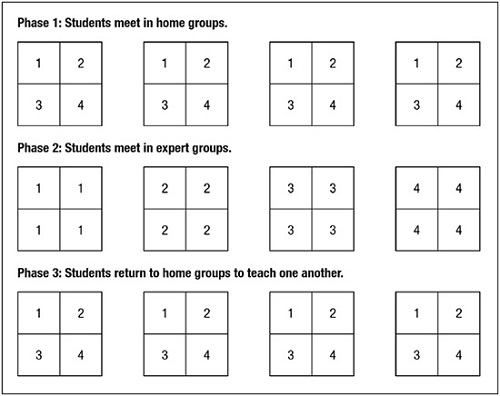
Image Credit:
Last spring I participated in a seminar through the Center for Teaching and Learning, and one of the biweekly sessions was on effective classroom organization. I resolved to try the Jigsaw Classroom model for my Fall 2013 class.
The Jigsaw Classroom is based on permanent student groups of around 4 students. More or fewer could work, though I've always liked the 4-person size. The basic idea is that the group members will work with each other throughout the semester. The advantages of this model are that activities retain some level of consistency, and students grow more comfortable participating within a stable group. Additionally, within each "home" group, each student is assigned a number--1, 2, 3, or 4--and when appropriate, the instructor separates all the groups into each number category. All the 1s will get together, all the 2s, etc. Each new group can work on a separate part of an activity or instructional concept, then when the main group of 1, 2, 3, and 4 gets back together, each student can instruct his or her home-groupmates about each concept. You can see an example of this structure in the image that heads this blog post.
For my first foray into the Jigsaw Classroom, I ended up seldom using the second part of this organizational strategy. My students remained in their home groups for nearly every group activity. First, I'll discuss how I organized the groups. I wanted their composition to be deliberate instead of random, especially because teaching in a computer classroom introduces the hurdle of some students not being familiar or comfortable with technology. I therefore created a Google Doc in which each student gave some information about their comfort level and experience with the types of tech we'd be using in our class. After each student had added their information, I began organizing the groups. I wanted each group to have at least one person with high skill and comfort levels, and one person with very low levels. I also tried to make the groups as gender-balanced as possible. I divided my 21 students into five groups (one group had five people), they chose their group name, and we got down to business.
In general the groups functioned just like groups randomly-chosen each day: class activities such as locating examples of certain concepts within a particular reading, or performing a rhetorical analysis of an image or song, were much as they had ever been. However, when we planned more in-depth activities, such as a group presentation or a trip to the Oakwood Cemetery, the permanent group idea really paid off. The students were more comfortable working on activities outside of the classroom with people they had already gotten to know. Group dynamics in general seem to be pretty high-functioning. At our individual midterm conferences, I asked each student their opinion of their groupmates' participation levels, functions, leadership, work ethic, and the overall effectiveness of the group. The vast majority of students felt that the workload was evenly shared, that certain roles (like note-taker or class reporter) were fulfilled on a generally rotating basis, and that the group experience was overall rewarding. One group became so close-knit that they elected to do their final digital research project together instead of individually, which puts them in each other’s' company for quite a while.
Initially I wanted to experiment with the Jigsaw Classroom because my previous Course Instructor Surveys noted that more groupwork would have been beneficial in those classes. I had never really considered myself "good" at setting up group activities, so I consciously pushed myself to try something new. I'd say that I have increased by at least two- or threefold the number of group activities I've incorporated into my teaching. Though it took some additional effort at first, I have definitely become more comfortable and confident with designing group activities and monitoring my students' participation through their home groups. It helps that the students consistently work with classmates they have come to know and are comfortable with, instead of having to navigate a new group dynamic every time. (I have also been lucky that no students have complained about their group members, though I made sure that any complaints or concerns would be addressed with the utmost respect and seriousness!)

